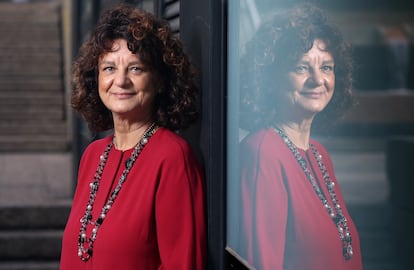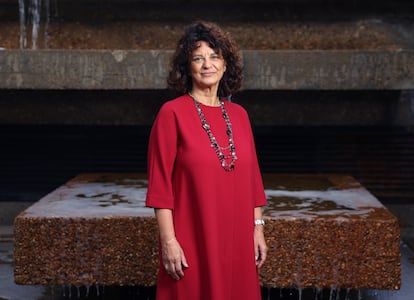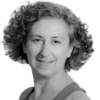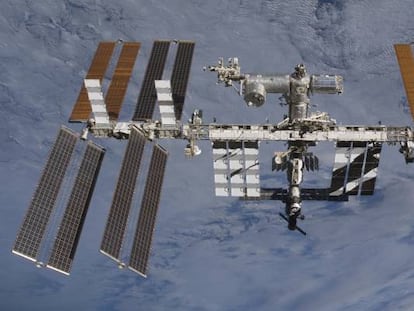Cecilia Hernández, from the European Space Agency: ‘The scientific return on a space mission is always assured’
Hernández is the first Spanish person to chair the agency’s Scientific Committee and its first female president

Cecilia Hernández was born in mainland Spain but grew up in Tenerife, one of the Canary Islands, before moving to Madrid to study a degree in Physics. Although her first intention was to work in research, since 1991 she has worked in various management posts in the field of science. She was at the Center for Technological Development and Innovation (CDTI) for many years, and just a few months ago, she joined the Spanish Space Agency, where she is head of the Science and Exploration Department. During her long period at the CDTI, Hernández has been head of the scientific program of the European Space Agency (ESA) twice, and that experience is what is most likely behind her recent appointment as president of the ESA’s Scientific Committee. Hernández is the first female president and the first Spaniard to chair that committee.
Question. What is the ESA’s scientific committee?
Answer. It is the body that decides how the funds allocated to the ESA science program should be managed and for what purpose. All twenty-two member states of the agency are represented.
Q. And how much are those funds?
A. Financing is approved for three-year periods. For the current period, we have just over €600 million ($656 million). The committee works with short, medium, and long-term planning that is used to decide which missions are carried out and with what money. Although we work on budgets spanning three years, in reality these missions are carried out over much longer periods of time. And that’s why sometimes you have to make adjustments, delay missions, modify planning, or even cancel missions.
Q. What can cause a space mission to be delayed or canceled?
A. Many things can happen. Sometimes we can see that they are going to be more expensive than expected, or the ministers do not approve a budget that was expected. Crises or technical failures occur. Many missions are also carried out with international collaboration, and that collaboration can vary with time.
Q. What type of science is done in the program whose committee you chair?
A. The scientific program is designed to advance knowledge, and in our case the fields we cover are astronomy, fundamental physics, and the science of the Solar System.
Q. And how is Spain doing in these fields?
A. I would say that, to a greater or lesser extent, it participates in all areas. The country is quite strong in astronomy. It’s no coincidence that we have large ground telescopes and different important research centers: the astrophysical centers in Andalusia and the Canary Islands and other centers such as the astrobiology center, the IFCA in Cantabria, the institute of space sciences in Catalonia, and many more. In addition to university departments, there are many research centers in Spain that have sound structural capabilities and facilities to participate and benefit scientifically from these missions.
Q. How does a research center benefit from working with ESA?
A. There is a double benefit: on the one hand, ESA scientific missions, and any other scientific mission aimed at doing what we call big science, want to answer the big questions that the universe can reveal to us. The demand for instrumentation is very strong, so a very direct benefit is the development of very demanding technologies. And that technological challenge ultimately comes from industry, so industry also benefits from that participation. What is more, the scientific return from having gotten involved in these missions means that you can have scientific production in this field. It is a sacrifice because the development of a mission from when it is proposed to when it is launched takes many years. It continues for a generation, but then the scientific return is always guaranteed.

Q. What are the most important missions that the scientific program has at the moment?
A. There is Gaia, an astronomy mission that is turning out to be the most productive in scientific terms. It has changed the paradigms of astronomy. It is basically mapping the sky. Another mission that was launched in March of this year is Juice, which is going to Jupiter, and all the instruments in it are challenging the state of the art. It is technologically very powerful. There are others like Solar Orbiter, which is also in flight, on its way to study the Sun. And then there are two that are at very interesting points. One of them that we hope to adopt in January 2024 — once study phase has come to an end — is the LISA mission, and its main objective is to detect gravitational waves. Another very nice one is Euclid, which was launched in July of this year and which is destined to reveal the mysteries of dark energy and matter. And following Euclid, last year the committee approved ARRAKHIS, the first mission led by a Spanish scientist. It is a complementary mission to Euclid that will study dark matter in particular. But consider that this mission was selected after competing with 18 others.
Q. What do you say when someone asks how can these millions be spent when there is still underdevelopment and hunger in the world?
A. I would tell you that if Galileo had not started looking at the sky we would not have all the optical instrumentation that we have today. Advancing in knowledge is inherent to human nature, and wanting to know where we come from and where we are going is unstoppable. You literally cannot stop it. The technology to do great science has subsequent technological applications, which are often unsuspected and are used in multiple fields. We always talk about medicine. But if we were not curious about what lies beyond, we would not now have Earth observation satellites that help us prevent, monitor, or alleviate catastrophes. We have the recent example of the La Palma volcano and how Copernicus, which is a satellite system developed by ESA, was following it step by step.
Q. Is the existence of the new Spanish Space Agency going to change Spain's relationship with the ESA?
A. Yes, of course. It is going to become a hub for all space-related matters in Spain. Until now, space powers were dispersed. But from now on, anyone from anywhere in the world, including the ESA, has a door to knock on when they want to talk about space with Spain. They will not get confused. With that alone we have already taken a giant step.
Q. The aerospace world is very male-dominated. What is it like to work in that field as a woman?
A. It was the same as in all male-dominated areas, but in recent years I have seen great changes. For the first time, the ESA’s director of science is a woman. There is huge awareness in the sector that we cannot afford to lose 50% of the talent, and the sector is proactive in seeking to attract women. The Spanish Space Agency itself has been created with the aim of applying equality policies. At the moment we are in good condition to move forward. On the other hand, the data is what it is, and society is what it is. As in other sectors, we must remember that certain situations are not tolerable and that a woman’s voice is as valuable as anyone else’s. We are the first generation to have to lose the baggage that we are carrying due to our education and the experiences in our personal careers, but our colleagues must help too. Honestly, if I am here it is thanks to Juan Carlos Cortés, who was my director at CDTI and has always supported me. We need men to work with us.
Sign up for our weekly newsletter to get more English-language news coverage from EL PAÍS USA Edition
Tu suscripción se está usando en otro dispositivo
¿Quieres añadir otro usuario a tu suscripción?
Si continúas leyendo en este dispositivo, no se podrá leer en el otro.
FlechaTu suscripción se está usando en otro dispositivo y solo puedes acceder a EL PAÍS desde un dispositivo a la vez.
Si quieres compartir tu cuenta, cambia tu suscripción a la modalidad Premium, así podrás añadir otro usuario. Cada uno accederá con su propia cuenta de email, lo que os permitirá personalizar vuestra experiencia en EL PAÍS.
¿Tienes una suscripción de empresa? Accede aquí para contratar más cuentas.
En el caso de no saber quién está usando tu cuenta, te recomendamos cambiar tu contraseña aquí.
Si decides continuar compartiendo tu cuenta, este mensaje se mostrará en tu dispositivo y en el de la otra persona que está usando tu cuenta de forma indefinida, afectando a tu experiencia de lectura. Puedes consultar aquí los términos y condiciones de la suscripción digital.
More information
Archived In
Últimas noticias
New York enters the era of Zohran Mamdani
Welcome to the post-religion era: The idea of Christianity as the absolute truth has become obsolete
‘I thought you would like it’: The risky sexual practice popularized by TV shows and TikTok
The digitalization of tourism: ‘They promise experiences and gave us the worst possible one’
Most viewed
- Sinaloa Cartel war is taking its toll on Los Chapitos
- Reinhard Genzel, Nobel laureate in physics: ‘One-minute videos will never give you the truth’
- Oona Chaplin: ‘I told James Cameron that I was living in a treehouse and starting a permaculture project with a friend’
- Why the price of coffee has skyrocketed: from Brazilian plantations to specialty coffee houses
- Silver prices are going crazy: This is what’s fueling the rally











































